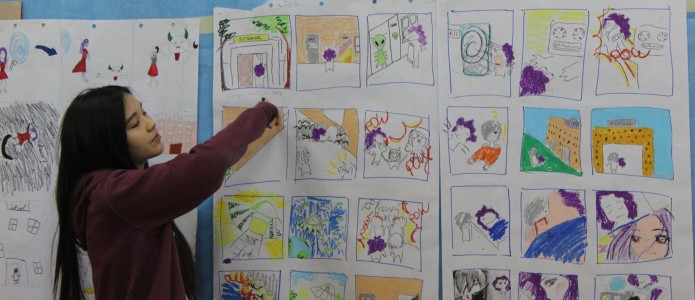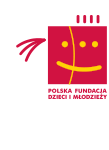
At first, I couldn’t even find the toilette because I didn’t know that a circle on the door stood for ‘ladies’ and a triangle for ‘gents’. I couldn’t figure out which room the class was at or that I was supposed to bring separate sports clothes and shoes for the PE class.
YiQi (pronounce: Eessee) is a 2nd grade student in a middle school. She travelled with her parents from China to Poland five years ago and enrolled in the primary school in the community of Mroków. She did not understand a single word of Polish. Today, she speaks fluently about her first few weeks in the new country and about how to survive in a world where everything is different.
School in Mroków
The local school in Mroków is very special. Ten percent of its students are of Chinese or Vietnamese origin. It is all because of the proximity of Wólka Kossowska, a home to a major wholesale hub that employs the Chinese and Vietnamese. Minority integration and students support projects have been available in the community for several years but many Chinese and Vietnamese still do not speak Polish one or two years after they start going to Polish schools. Here is the problem:
Foreign children are required to study all subjects in Polish right away. Biology, history, geography – all in a language that is totally incomprehensible to them. Result? I have recently spoken to one parent whose child will be held back for the third time. It means the boy has been stuck in the third grade in the middle school ever since he arrived in Poland, Michalina Jarmuż of the World within Reach Foundation explains. Michalina has run a Mini Polish Phrasebook project in Mroków since October 2014.
However, language is not the only challenge faced by immigrant children in Polish schools.
I helped one Chinese boy with his maths homework once. The task was to develop a mathematical formula and was to do with the calendar. Nothing special, you’d think. The thing is, Poland and China have different calendars! So I had to tell him first about the Polish calendar, how many days it has and how you can structure them. The cultural context is noticeable in all subjects, and even in sciences some problems to be solve have narrative descriptions so both hurdles at once form an insuperable barrier, says Jarmuż.
Foreigner in a Polish School
According to Polish legislation, a foreign child who stays in Poland has not so much a right but an obligation to attend school. In addition, children of foreign descent have the right to additional five hours of Polish classes per week. These five hours of language classes a week seem to be a sufficient support for young migrants to pick up the language. The trouble is these language classes are organised after the mandatory subject-matter classes.
These kids have psychosomatic symptoms after the whole day of listening to instruction in a language they do not understand – they have headaches and abdominal pains. As laconic as it may sound, the school nurse has confirmed they exhibit all the symptoms of anxiety and culture shock. Learning in such a state is extremely difficult, explains Jarmuż.
This is coupled with a simple fatigue and frustration seeing all the other classmates long gone home or playing outside.
Solutions
Other countries in Europe where migrant populations are much higher than in Poland have long implemented policies to help young foreigners adapt to the local school environment. In Norway, where migrants account for 15 per cent of the population young students who speak other languages than Norwegian enjoy the right to addition language learning which lasts until they are ready to attend regular classes at school.
Students have the right to learn in their native language or in both languages. This approach applies to children who recently arrived in Norway and children who have limited language skills in Norwegian because of foreign descent. Students can choose their native language as an additional foreign language in secondary schools, says Dag Fjæstad of the National Centre for Multicultural Education, who was invited by the Polish Children and Youth Foundation to attend a seminar for organisations that implement youth and anti-discrimination projects in the framework of the Citizens for Democracy program.
Poland made a positive step towards the Nordic approach by introducing a transition period for students to learn the language before they begin regular education.
I myself attended a Polish school with French as the language of instruction. We spent the first year essentially learning French for 20 hours a week. After than year, we were truly prepared to study all other subject is the language, recalls Aleksandra Ośko, President of the World within Reach Foundation.
However, schools like the one in Mroków are still relatively rare. The total migrant student population in Poland is at 1 per cent, which means it is not seen as priority and some fail to recognise it at all. Municipalities and schools that face the challenge appear to be patching the holes in the system by engaging with non-governmental organisations.
Mini Polish Phrasebook
For example, Mini Polish Phrasebook is a project implemented in the school in Mroków by the STEP Education and Progress Association in partnership with the World within Reach Foundation and Project: Poland.
Any type of support and assistance is important whenever young immigrants land in a Polish school.
The first few weeks were very hard. I was lucky to find a friend quickly, a Polish girl. First, we communicated through drawings. I would draw things and she would tell me what these things were in Polish. Surely, a phrasebook with basic Polish phrases, a survival dictionary of sorts, would have helped initially, concludes YiQi.
During a winter holiday workshop organised at the school in Mroków, young Poles, Vietnamese and Chinese worked with photographer Marta Kotlarska to develop pinhole photography skills. They then used their photographs to produce a picture game that helps learn basic Polish.
We selected over 20 key sentences to help new students get by. We realise this tool is not going to solve all the problems. But it is likely to be the first positive thing that may encourage young foreigners to learn Polish, says Aleksandra Ośko.
The game will be published in five language versions: Polish, Chinese, Vietnamese, English and Norwegian. Besides the new tool, the workshop had another measurable outcome.
Polish kids could at last see that their peers from China or Vietnam were also talented, could paint beautiful pictures, had maths skills and could tell sophisticated stories. They had not had the chance to demonstrate this in regular classes. Further, Polish students happened to be a minority in work groups. They would rush to us crying: I am alone with all these Chinese children, I don’t understand anything, what am I supposed to do?! The experience of getting in the shoes of foreign peers for a while made a huge impact on the Polish kids, laughs Aleksandra Ośko.
What Next?
Poland has become an attractive country for migrants. The number of children of foreign decent has been steadily growing and these challenges will soon no longer be faced just in areas close to the national borders, refugee centres or trade hubs. Initiatives such as the Mini Polish Phrasebook could then be seen as a good practice worth replicating elsewhere.
About the Project:
Mini Polish Phrasebook is a project designed to bridge a gap in the education system in Poland. It seeks to develop a communication tool to help non-Polish speaking students improve their performance in Polish schools. It offers a project-based learning for 20 students who will take part in a creative workshop and will develop a picture-based Polish phrasebook.
The project is implemented by the ‘STEP’ Education and Progress Association in partnership with the World within Reach Foundation and Project:Poland from Iceland, in the framework of the Citizens for Democracy program funded by EEA Funds.




